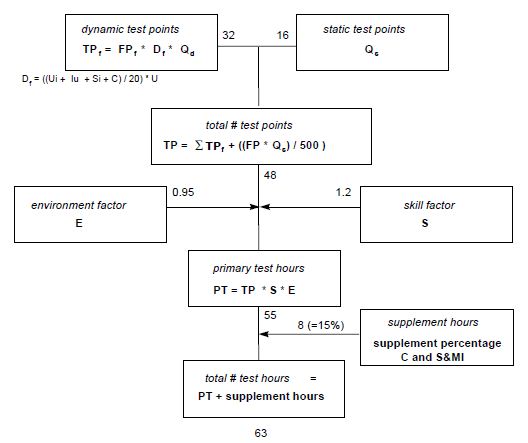Since every test process involves secondary activities from the Control phase and the Setting up and maintaining
infrastructure phase, a supplement must be added to the primary test hours for this. This will eventually result in the
total number of test hours. The number of supplemental hours is calculated as a percentage of the primary test
hours.
The supplemental percentage is often determined by a test manager on the basis of experience or using historical data.
Some organisations use a fixed percentage. The percentage is nearly always in the range of 5 to 20%.
If no experience, historical data or fixed percentages are available, a supplemental percentage can be estimated in the
following way. A standard (nominal) supplemental percentage of 12% is used as the starting point. We must then look at
factors that may increase or reduce the percentage. Examples of such factors are:
-
Team size
-
Management tools
-
Permanent test organisation.
These factors are explained below. Since there is a great variety of test projects, we have not used seemingly certain
absolute percentage figures to determine the impact of these factors on the percentage, but have chosen to indicate
whether the impact will increase or reduce the percentage.
Team size
The team size represents the number of members in the test team (including the test manager and a test administrator,
if any). A big team usually results in greater overhead and therefore a higher supplemental percentage. However, a
small test team results in a reduced percentage:
-
Reduction - Test team consists of maximum 4 persons
-
Neutral - Test team consists of 5 - 9 persons
-
Increase - Test team consists of at least 10 persons.
Management tools
For management tools, it is considered to what extent automated tools are used during the test activities for Control
and Setting up and maintaining infrastructure. Examples of these tools are an automated:
-
planning system
-
progress monitoring system
-
defect administration system
-
testware management system.
If little use is made of automated tools, certain activities will have to be done manually. This increases the
supplement percentage. If intensive use is made of automated tools, this will reduce the percentage:
-
Reduction - At least 3 automated tools are used
-
Neutral - 1- 2 automated tools are used
-
Increase - No automated tools are used.
Permanent test organisation
There are many kinds of permanent test organisation. If an organisation has one of these permanent test
organisations, lead time reduction, cost savings and/or quality improvement are often realised in a test process that
uses it.
-
Reduction - Test team uses the services of a permanent test organisation
-
Neutral - Test team does not use the services of a permanent test organisation.
Calculation example 1 - Determining supplement for Control and Setting up and maintaining infrastructure (C and
S&MI)
Historical data show the supplement percentage for such test projects to fluctuate around 15%. The test manager decides
to use this percentage.
Supplement percentage C and S&MI = 15%
Calculation method
The supplemental percentage is used to calculate the supplement (in hours) on the basis of the number of primary test
hours. The total number of test hours is then obtained by adding the supplement calculated for Control and Setting up and
maintaining infrastructure to the total number of primary test hours.
Calculation example 2 - Calculation of total number of test hours
|
Primary test hours
|
55
|
|
Supplement C and S&MI
|
55 * 0.15 = 8.25 (rounded down:
8)
|
Total number of hours
|
55 + 8 = 63
|
Figure below shows the TPA calculation example as a whole.

Figure 1: Schematic representation of calculation example
|
